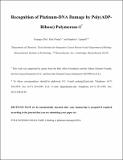| dc.contributor.author | Zhu, Guangyu | |
| dc.contributor.author | Chang, Paul | |
| dc.contributor.author | Lippard, Stephen J. | |
| dc.date.accessioned | 2011-07-07T14:34:10Z | |
| dc.date.available | 2011-07-07T14:34:10Z | |
| dc.date.issued | 2010-06 | |
| dc.date.submitted | 2010-06 | |
| dc.identifier.issn | 0006-2960 | |
| dc.identifier.issn | 1520-4995 | |
| dc.identifier.uri | http://hdl.handle.net/1721.1/64758 | |
| dc.description.abstract | Poly(ADP-ribose) polymerase-1 (PARP-1) was recently identified as a platinum−DNA damage response protein. To investigate the properties of binding of PARP-1 to different platinum−DNA adducts in greater detail, biotinylated DNA probes containing a site-specific cisplatin 1,2-d(GpG) or 1,3-d(GpTpG) intrastrand cross-link or a cisplatin 5′-GC/5′-GC interstrand cross-link (ICL) were utilized in binding assays with cell-free extracts (CFEs) in vitro. The activated state of PARP-1 was generated by treatment of cells with a DNA-damaging agent or by addition of NAD+ to CFEs. PARP-1 binds with a higher affinity to cisplatin-damaged DNA than to undamaged DNA, and the amount of protein that binds to the most common cisplatin−DNA cross-link, 1,2-d(GpG), is greater than the amount that binds to other types of cisplatin−DNA cross-links. Both DNA damage-activated PARP-1 and unactivated PARP-1 bind to cisplatin-damaged DNA, and both automodified PARP-1 and cleaved PARP-1 bind to cisplatin−DNA lesions. The role of poly(ADP-ribose) (pADPr) in mediating binding of PARP-1 to platinum damage was further investigated. The extent of binding of PARP-1 to the cisplatin 1,2-d(GpG) cross-link decreases upon automodification, and overactivated PARP-1 loses its affinity for the cross-link. Elimination of pADPr facilitates binding of PARP-1 to the cisplatin 1,2-d(GpG) cross-link. PARP-1 also binds to DNA damaged by other platinum compounds, including oxaliplatin and pyriplatin, indicating protein affinity for the damage in an adduct-specific manner rather than recognition of distorted DNA. Our results reveal the unique binding properties for binding of PARP-1 to platinum−DNA damage, providing insights into, and a better understanding of, the cellular response to platinum-based anticancer drugs. | en_US |
| dc.description.sponsorship | Rita Allen Foundation | en_US |
| dc.description.sponsorship | National Cancer Institute (U.S.) (CA034992) | en_US |
| dc.language.iso | en_US | |
| dc.publisher | American Chemical Society | en_US |
| dc.relation.isversionof | http://dx.doi.org/10.1021/bi100775t | en_US |
| dc.rights | Article is made available in accordance with the publisher's policy and may be subject to US copyright law. Please refer to the publisher's site for terms of use. | en_US |
| dc.source | Prof. Lippard via Erja Kajosalo | en_US |
| dc.title | Recognition of Platinum−DNA Damage by Poly(ADP-ribose) Polymerase-1 | en_US |
| dc.type | Article | en_US |
| dc.identifier.citation | Zhu, Guangyu, Paul Chang, and Stephen J. Lippard. “Recognition of Platinum−DNA Damage by Poly(ADP-ribose) Polymerase-1.” Biochemistry 49.29 (2010) : 6177-6183. | en_US |
| dc.contributor.department | Massachusetts Institute of Technology. Department of Chemistry | en_US |
| dc.contributor.department | Koch Institute for Integrative Cancer Research at MIT | en_US |
| dc.contributor.approver | Lippard, Stephen J. | |
| dc.contributor.mitauthor | Lippard, Stephen J. | |
| dc.contributor.mitauthor | Zhu, Guangyu | |
| dc.contributor.mitauthor | Chang, Paul | |
| dc.relation.journal | Biochemistry | en_US |
| dc.eprint.version | Author's final manuscript | en_US |
| dc.type.uri | http://purl.org/eprint/type/JournalArticle | en_US |
| eprint.status | http://purl.org/eprint/status/PeerReviewed | en_US |
| dspace.orderedauthors | Zhu, Guangyu; Chang, Paul; Lippard, Stephen J. | en |
| dc.identifier.orcid | https://orcid.org/0000-0002-2693-4982 | |
| mit.license | PUBLISHER_POLICY | en_US |
| mit.metadata.status | Complete | |
